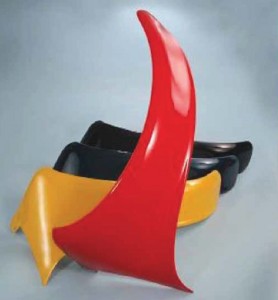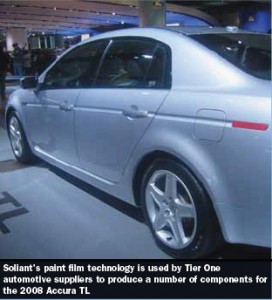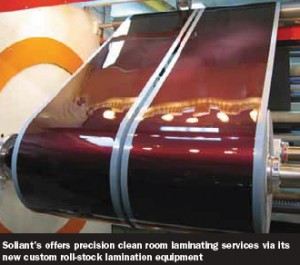
Paint-free technology for automotive applications is moving forward at a rapid pace, driven by a need for environmentally-friendly and cost-effective alternatives to traditional painting operations. Paint films provide huge benefits, such as the elimination of paint lines and their associated emissions of Volatile Organic Compounds (VOCs). They also reduce the pervehicle costs of manufacturing.
Estimates from SABIC Innovative Plastics (formerly GE Plastics) show that automotive paint films offer a $5 billion/350 million tonne opportunity for the paint films industry. However, the uptake of paint films is lagging behind manufacturer expectation and the reason for the slow adoption is primarily because carmakers and suppliers have invested billions of dollars over the past two decades in large-scale, automated painting operations. SABIC puts the cost of constructing a large-scale painting facility at about $400m and there is a proliferation of these facilities in the US. With this in mind it is easy to understand the reluctance of the industry to abandon them in favour of completely new technology.
 Environmental concerns are a primary driver in the use of paint films and in 2006 Soliant received the Environmental Award in the “Emerging Technologies” category at the Society of Plastics Engineers Global Plastics Environmental Conference (GPEC) for its paint film process. Soliant was able to demonstrate a 98 per cent reduction in emissions based on an analysis of the production and use of their product compared to traditional vehicle painting. In 2008, Soliant once again received a GPEC award in the “Enabling Technologies in Processes and Procedures” category for its Fluorex bright film, a sustainable, recyclable alternative to chrome plating. Bright film eliminates the use of plating chemicals and processes, which in turn reduces the amount of VOCs generated in conventional chrome plating. Fluorex also offers weight savings which improves fuel economy, can be used on many plastic substrates including TPO, ABS, PC, PVC, and PC/ABS, and is 100 per cent recyclable.
Environmental concerns are a primary driver in the use of paint films and in 2006 Soliant received the Environmental Award in the “Emerging Technologies” category at the Society of Plastics Engineers Global Plastics Environmental Conference (GPEC) for its paint film process. Soliant was able to demonstrate a 98 per cent reduction in emissions based on an analysis of the production and use of their product compared to traditional vehicle painting. In 2008, Soliant once again received a GPEC award in the “Enabling Technologies in Processes and Procedures” category for its Fluorex bright film, a sustainable, recyclable alternative to chrome plating. Bright film eliminates the use of plating chemicals and processes, which in turn reduces the amount of VOCs generated in conventional chrome plating. Fluorex also offers weight savings which improves fuel economy, can be used on many plastic substrates including TPO, ABS, PC, PVC, and PC/ABS, and is 100 per cent recyclable.
Fluorex bright film is extremely durable and is weather, chemical and chip resistant. This technology is very timely given that new permits for the chrome plating process are becoming increasingly more difficult to obtain. With advancements in Soliant’s technology, the company’s Fluorex bright film product can be used in a variety of processes including injection moulding, thermoforming, insert injection moulding, compression moulding and extrusion applications. Soliant has more than a 20-year history as a producer of paint film products for automakers and is now capable of covering all decorated surfaces. Fluorex is being used to provide thick-sheet thermoformed parts in high volumes, as well as injection moulded applications for a number of major automotive OEMs including Honda, General Motors and Toyota in the US, and leading European automakers such as Audi, Volvo, and Mercedes. According to Soliant, automotive OEMs are beginning to demonstrate a greater interest in paint film because in addition to being environmentally sound, Fluorex paint films are offered in virtually any colour requested by the OEM including mono-chromatic, metallic and pearlescent colour schemes.
Fluorex paint films also meet all interior and exterior automotive specifications. Soliant’s Cupstid says there is a lot of misinformation about what is possible with paint film, including confusion regarding whether colour can be matched with painted surfaces. He clarifies that this some Soliant specialises in, citing vehicles such as the Honda Odyssey and others from Toyota, whose colours range from white to silver metallic. These paint film components are fitted next to painted metal and plastic with a perfect match. Cupstid also points to components such as roof modules on which the all-plastic roof module has all the electronics built into it – something that can’t be done with metal – to provide weight savings and cost savings in the vehicle build process. “The complete roof module can be sent directly to the OEM, ready to assemble onto the vehicle,” he said.
That said, bankruptcies among Tier One suppliers such as Plastec and Collins & Aikman, means the market is opening up somewhat and there might just be a way in for paint-free technologies
In creasing demand
creasing demand
John Cupstid, Sales and Marketing Director for Soliant, agrees that the opportunities for growth in paint film are tremendous and that demand in applications for automotive exteriors is increasing. Soliant is also experiencing a lot of demand for its products in Europe, where Soliant BV operates in the Netherlands. “Paint film can be perceived as a disruptive technology to traditional painting,” Cupstid admits. “We probably won’t sell our products to someone who’s just put it in a $200m painting facility, but we do sell some paint film to some painting companies. The lion’s share of our sales goes to those who don’t have painting facilities.” While admitting that paint film will never completely replace paint, Cupstid notes there are many plastic applications for which painting is a problem, such as thermoplastic polyolefins (TPOs). Typically, when applying conventional paint to TPO components, it requires spraying bonding layers onto the part prior to the actual paint application in order to get proper adherence. “Our film has an adhesive layer that bonds the TPO to the paint film,” says Cupstid.
 SABIC Innovative Plastics developed a solution for Opel when the European automaker wanted to introduce an updated model of its Zafira compact van. The van’s design features a unique roof module with four large, rectangular window insets. Running down the centre of the roof module is a series of five handy, built-in storage boxes accessible from inside the van. Opel had several material requirements for the Zafira roof, including exceptional gloss to complement the glass inserts, rich colour and high performance under tough driving conditions. A major consideration in the material selection however, was that it should address environmental concerns about harmful VOCs. To achieve these goals, Opel selected Lexan SLX film from SABIC Innovative Plastics. The Zafira roof module is back-moulded using a polyurethane Long- Fibre Injection (LFI) substrate and pre-formed Lexan SLX film. The multi-layer structure is infused with pigment, providing inherent colour and gloss while eliminating the need for secondary priming, painting and coating operations that can release VOCs.
SABIC Innovative Plastics developed a solution for Opel when the European automaker wanted to introduce an updated model of its Zafira compact van. The van’s design features a unique roof module with four large, rectangular window insets. Running down the centre of the roof module is a series of five handy, built-in storage boxes accessible from inside the van. Opel had several material requirements for the Zafira roof, including exceptional gloss to complement the glass inserts, rich colour and high performance under tough driving conditions. A major consideration in the material selection however, was that it should address environmental concerns about harmful VOCs. To achieve these goals, Opel selected Lexan SLX film from SABIC Innovative Plastics. The Zafira roof module is back-moulded using a polyurethane Long- Fibre Injection (LFI) substrate and pre-formed Lexan SLX film. The multi-layer structure is infused with pigment, providing inherent colour and gloss while eliminating the need for secondary priming, painting and coating operations that can release VOCs.
Thermoforming and moulding
Currently, paint films are being used primarily in applications such as claddings, rocker panels and bumper fascias. There are two primary methods of applying paint film to these sorts of parts. One involves thermoforming: a “thermoformable” film is made in the desired shape, which is then inserted into an injection mould cavity and moulding the thermoplastic substrate behind the form. The other method is putting the film directly into the cavity of the injection mould or thermoform mould, and moulding the component.
Michigan-based Durakon Industries is a leading provider of thermoformed products and paint film technology to the automotive industry. Dennis DeLeonard, Vice President of Sales and Marketing, says the company started down the paint film path about four to five years ago with a project for GM. It began with the Chevrolet SSR and actually evolved into two projects. “Vehicles like the SSR are created as a technology test base for the OEM to show off their technology,” DeLeonard explains. “They produce things on a smaller scale and if works out, they bring it to a larger scale.”
The project involved fenders for the Chevy SSR that were similar to those of the old Volkswagen Beetle; they stuck out and therefore had a problem with rock impingement. According to DeLeonard, GM needed stone shields the same colour as the body that would be “sacrificial parts”. DeLeonard explains: “After you have them on for a while and they become chipped, you can snap them off and buy more for replacement.”
For automotive suppliers looking for an alternative to both painting and paint films, A.Shulman offers its Invision sheet products. Manufactured in Sharon Center, Ohio, Invision is a patented ionomer-based sheet providing high-gloss, Class “A” decorative surfaces. It is a thermoplastic sheet that is resistant to cracking and peeling, and is 100 per cent recyclable back into the material stream. It is suitable for many different processes including thermoforming, blow moulding, rotational moulding and injection moulding processes. The uniquely structured four-layer sheet includes the industry’s thickest layer of colour compared to the paint film industry, precisely matched at Invision’s manufacturing facility. This colour layer eliminates the risk of bubbling, chipping, staining and fading with the long-lasting benefits of superior colour and product protection. This thick colour layer combined with a superior substrate provides the performance of draw ratios of over 500 per cent without substantial loss of colour properties. Invision comes in either cut sheet or roll form.
Learning process
Durakon launched the programme in “an unbelievably short time frame: about 30 days”, then had to catch up with all the internal processes. “The product worked very well and we learned an awful lot about the paint film process and by adding paint film we’re adding value. The OEMs or Tier One suppliers don’t have to paint the parts, they can cut VOCs and create a part that is more chip resistant than normal paint,” says DeLeonard. Initially the Chevy SSR vehicle came without a running board, so that was developed and a Class B running board, themoformed using twin sheet construction, was added to finish off the vehicle. “Initially it was a grey colour, then we began offering the running boards in all the same colours as the vehicles, which was a technology test for us.” Having success on that programme allowed Durakon to redefine what paint film is and the role it plays in automotive components. Through its proprietary process, that also involves manufacturing its own sheet to ensure quality control. The paint film is applied to the extruded sheet in a clean room environment to optimise quality and reduce scrap.
Avery Dennison Avloy formable decorative paint film provides an exterior grade, Class “A” finish that is compatible with injection-moulded plastic. The multilayer material is constructed from the highly-durable and fade-resistant Kynar 500 from Arkema. It includes a thermoplastic substrate (ABS, TPO or PC), a thermoplastic tie-coat, an acrylic colour coat, followed by an optional print design if required, topped by a PVDF clear coat. Avloy can be supplied as a thick sheet, or as roll form up to 0.030 inches for thin sheet injection moulding. To process the formable film, a thermoformer pre-shapes the part by heating and forming the film. The preform is then inserted into the injection-mould cavity where the resin bonds with the preform shell so the Avloy finish is permanently integrated into the finished part. Avery Dennison’s patented application process is capable of dispersing metallic flakes and pigments to replicate the appearance of traditional paint systems. It comes in both low- and high-gloss finishes, and in solids, metallic, pearlescents, and tinted clearcoats, providing automotive designers greater freedom in developing new patterns and colours not possible with conventional paint systems. Advances in thermoplastic paint films that can be reclaimed with the substrate are becoming increasingly desirable as it eliminates the need for removal of the paint from the substrate prior to recycling, a generally expensive and sometimes ineffective process.
 High-volume production
High-volume production
Durakon’s work with thermoformed paint films has led to additional contracts. Its work on the lower front fascia for the Jeep Liberty has ended with that vehicle no longer in production but the work on components for the Saab 9-7 still continues. “The breakthrough programme was the rocker panel for the Buick Lucerne which we now make in 18 colours,” says DeLeonard. “We’re the only supplier of rocker panels for that vehicle and we make them in Lapeer where our R&D division is located.” In January, 2006, Durakon announced that it would begin high-volume production of the rocker panel. The company’s CEO, Ed Gniewek, says: “Our initial efforts and products were directed at niche vehicles of lower volume applications and those earlier results were impressive and lauded by the industry. The decision of GM to expand use of our thermoformed paint film products to its high production Lucerne model reflects the level of design, technology and quality that we have been able to deliver to the industry on a consistent basis.” Durakon produces approximately 250,000 rocker panels annually for GM.
Installing paint film technology comes with a fairly high price tag. DeLeonard recognises that for Durakon, “it’s come with an investment of many millions of dollars,” but he sees it paying off. “We’ve now started our third product group at Durakon, but we feel we’re just scratching the surface as far as market share.” While paint film technology promises to offer a good return on investment attention needs to be paid to when doing so. DeLeonard concludes: “I think you have to be very careful with accounting. Is it a short term or long term rationalisation? We have a better part with better appearance and better chip resistance. Over time, when you add up all the extra steps and costs involved in painting something, this paint film technology really starts to make a lot of sense.”
Advanced Composites produces low-gloss compounds for automotive interior components such as instrument panels. The company also develops and manufactures scratch-resistant Mold-In-Color TPO compounds offering high-gloss exterior and moulded-in colour, rivalling both traditional painting and paint films. Anthony Gasbarro, Business Development Coordinator, says that new developments in Advanced Composites’ materials for automotive uses are being widely accepted. The company has recently developed a series of TPO products providing Mould-In- Colour to achieve full-gloss exterior metallic finishes.
Tests done on TPO Mold-In-Color shows a greater than 10N scratch resistance. While the use of high-gloss paint films show imperfections, testing with the TPO Mold-In-Color shows excellent mar resistance and gloss retention: 95 per cent gloss retention in gold colour, and 97 per cent gloss retention in grey. Stone chip resistance is becoming more critical as vehicles become lower to the ground, Gasbarro notes. The major disadvantage is the scratches in paint films can result in the black substrate material showing through. “In Mold-In-Color you don’t have these black scratches,” he says.
Advanced Composites produces an ADX 7000 material, which is a moulded-in colour resin that also eliminates the need for paints and primers, as well as all the related VOCs associated with the extensive painting process. There is also the advantage of a reduction in energy consumption. The ADX 7000 material also provides ease of recycling the components as there is no film that has to be stripped away prior to recycling the thermoplastic substrate.





































